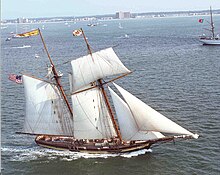Baltimore clipper

Baltimoreklipper , also Baltimoreklipper and Baltimoreklipperschoner , is the name of a type of ship that originally developed on the east coast of North America . They were agile, mostly two-masted sailing ships with flat held bowsprit / bowsprit , mostly convex bow , high, according aft inclined masts, low bulwark , a relatively large sail area and sharp ship lines. They were as Bermuda saver , Gaffelschoner than Rahschoner (Rahtopp with at least one square sail ), as Brigantine , Brigg well and rarely as a frigate rigged.
history
The origins of the Baltimore clipper were in 16th century England. The forerunner of this type of ship came to the American colonies with the British. The first true clipper of its kind was built on Chesapeake Bay at the end of the 18th century, first in Virginia as a typical pilot boat, then in Baltimore , Maryland , and in other ports on the American east coast. The topsail schooner variants soon got a reputation as excellent fast ships as far as Europe, where they were also replicated (France).
Due to their excellent sailing properties, the Baltimore clippers were soon used as ocean-going warships and blockade breakers ( Napoleonic Wars , British-American War of 1812), light cargo and mail ships (especially after 1818), but also as slaves, smugglers - ( opium -, Slave clippers), pirate and privateers especially in the Caribbean . The Baltimore clippers were not designed for the largest possible cargo volume, but for speed. Its heyday was between 1795 and 1825.
A replica of a Baltimore clipper was the Pride of Baltimore , which was built in Baltimore from 1975 to 1977 with great emphasis on authenticity. After her sinking in 1986, the Pride of Baltimore II was built in 1988 , which is historically incorrect but still gives a good impression of a Baltimore clipper.
Origin of name
The name " Klipper " as a synonym for a fast ship was then carried over to the cargo-carrying clippers ( full ships ) from the years 1840 to 1860, which emerged from the development of the Baltimore clipper. The ship type of the Baltimore clipper continued to exist as a fishing boat, pilot boat and yacht.
See also
Individual evidence
- ^ HI Chapelle, "The Baltimore Clipper," 1930, The Marine Research Society / Bonanza Books, Library of Congress Catalog Card Number: 76 27148
- ↑ Parrott, Daniel. (2003). Tall Ships Down - the last voyages of the Pamir, Albatross, Marques, Pride of Baltimore and the Maria Asumpta. McGraw Hill. (Pp. 225–227)
